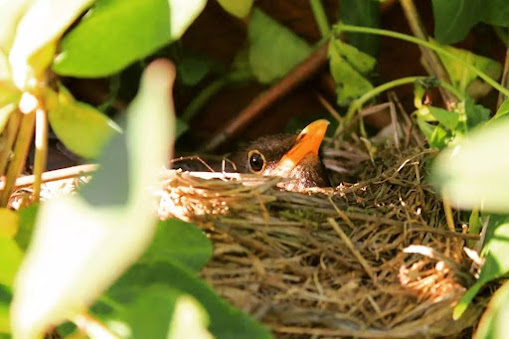To my amazement, in late April I discovered a female blackbird had started building a nest in the shallow honeysuckle hedge in my garden which laid against a trellis. I had only put this structure in place the previous year. Before long there was a clutch of four hatchlings, which whittled down to one, with some unfortunate losses by expulsion from the nest. The final remaining fellow was a lively one, and I saw it jump from the nest much to the alarm of its mother who squawked vociferously. Between them, they hopped about in the ground cover plants in my veg plot and borders for about a week, and after that I didn't see them. I'm assuming the fledgling learnt to fly because I didn't find any dead fledglings around the garden, which is the patrolling cat's usual modus operandi. Below is a good summary of blackbird nest building and rearing from the RSPB:
The normal clutch size is 3-5. Larger clutches are laid in woodland than in gardens. The female incubates alone, and the chicks hatch 13-14 days later. Only the female broods the chicks, but both parents feed them. Chicks in gardens are fed on earthworms when they are available; woodland chicks are fed mainly on caterpillars.The chicks are ready to fledge at 13-14 days, but if the nest is disturbed, they can leave and survive as early as nine days old. This ability to fledge early is an important anti-predator adaptation. The young birds creep and flutter from the nest, and remain in nearby cover for the following few days.They are flightless at first, but within a week will have learned to fly. By this time, they begin to experiment with foods, learning by trial and error what is edible. As their skills and confidence grow, they begin to explore their parents' territory and range more widely. The young become independent three weeks after leaving the nest, and leave the natal area shortly after. They are not driven away by the male.Fledged young are often left in the care of the male, while the female prepares for the next nesting attempt. The last brood of the season is usually divided between the parents, with each adult taking sole care of some of the young.There are considerable losses at the egg and chick stage, with at best 30-40 per cent of nests producing fledged young. Despite smaller clutch sizes, birds in towns fledge more chicks per nest than birds in the countryside.





